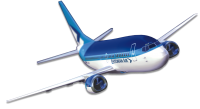Difference between revisions of "Projects:2016s1-126 A Trash Collecting Robot"
(→Foreign Object Debris Collecting Robot) |
(→Foreign Object Debris Collecting Robot) |
||
| Line 20: | Line 20: | ||
FOD is a major cause of concern on airport runways as it it a precursor to aircraft damage. FOD can consist of objects such as aircraft parts, tools, wildlife and personal effects. Current processes do not sufficiently address the FOD issue. The proposed project relies on an autonomous robot to collect FOD before it poses a threat to aircraft. Path-planning, cost analysis and testing trust are the major technical challenges of the project that are explored by the team members. This project follows a System Engineering approach meaning that documents which are created will be based upon preceding documents. A Concept of Operations, System Requirements Document and Interim Engineering Reports (IER) have been produced, with the IER addressing the technical challenge and providing part of the overall feasibility study into its specific field. | FOD is a major cause of concern on airport runways as it it a precursor to aircraft damage. FOD can consist of objects such as aircraft parts, tools, wildlife and personal effects. Current processes do not sufficiently address the FOD issue. The proposed project relies on an autonomous robot to collect FOD before it poses a threat to aircraft. Path-planning, cost analysis and testing trust are the major technical challenges of the project that are explored by the team members. This project follows a System Engineering approach meaning that documents which are created will be based upon preceding documents. A Concept of Operations, System Requirements Document and Interim Engineering Reports (IER) have been produced, with the IER addressing the technical challenge and providing part of the overall feasibility study into its specific field. | ||
| + | ===Motivation=== | ||
| + | |||
| + | FOD induced direct, indirect, and birdstrikes costs, cost the airline industry $13.91 billion USD per annum. Taking into account that 50% of FOD strikes occur on the tarmac means that $6.215 billion is spent on FOD found on runways. Total aviation profit in 2011 was $7.9 billion USD. These figures show that the aviation profit can be significantly increased (nearly doubled) if FOD is correctly addressed. The project team, estimates that Adelaide airport can save up to $160,000 USD per annum on direct costs and ten times this amount including indirect costs such as delays and inefficiencies. The FAA estimates that runway inspections only uncover 3-4% of FOD present on the runway on that day. Another factor is that humans can become fatigued and perform less efficiently. An automated solution that is able to remove humans from the process can also remove their associated flaws and provide better FOD collection and detection. | ||
| + | |||
==Task allocation== | ==Task allocation== | ||
As aforementioned the project was broken down into three separate technical challenges. These challenges are explored in-depth below. | As aforementioned the project was broken down into three separate technical challenges. These challenges are explored in-depth below. | ||
| Line 28: | Line 32: | ||
===Control and Simulation==== | ===Control and Simulation==== | ||
| + | |||
| + | ==References== | ||
| + | The information contained in this wiki has been derived from findings present in each members thesis. | ||
Revision as of 11:20, 26 October 2016
Contents
Project Group
- Gregory Davill
- Michael Poon
- Tony Daidone
Supervisors
- Braden Phillips
- Michael Liebelt
Foreign Object Debris Collecting Robot
Aim:
Conduct a feasibility study into an autonomous robot to collect Foreign Object Debris (FOD) from airport runways.
Project Overview:
FOD is a major cause of concern on airport runways as it it a precursor to aircraft damage. FOD can consist of objects such as aircraft parts, tools, wildlife and personal effects. Current processes do not sufficiently address the FOD issue. The proposed project relies on an autonomous robot to collect FOD before it poses a threat to aircraft. Path-planning, cost analysis and testing trust are the major technical challenges of the project that are explored by the team members. This project follows a System Engineering approach meaning that documents which are created will be based upon preceding documents. A Concept of Operations, System Requirements Document and Interim Engineering Reports (IER) have been produced, with the IER addressing the technical challenge and providing part of the overall feasibility study into its specific field.
Motivation
FOD induced direct, indirect, and birdstrikes costs, cost the airline industry $13.91 billion USD per annum. Taking into account that 50% of FOD strikes occur on the tarmac means that $6.215 billion is spent on FOD found on runways. Total aviation profit in 2011 was $7.9 billion USD. These figures show that the aviation profit can be significantly increased (nearly doubled) if FOD is correctly addressed. The project team, estimates that Adelaide airport can save up to $160,000 USD per annum on direct costs and ten times this amount including indirect costs such as delays and inefficiencies. The FAA estimates that runway inspections only uncover 3-4% of FOD present on the runway on that day. Another factor is that humans can become fatigued and perform less efficiently. An automated solution that is able to remove humans from the process can also remove their associated flaws and provide better FOD collection and detection.
Task allocation
As aforementioned the project was broken down into three separate technical challenges. These challenges are explored in-depth below.
Trust and Testing
Cost analysis
Control and Simulation=
References
The information contained in this wiki has been derived from findings present in each members thesis.
